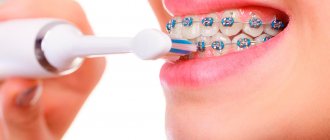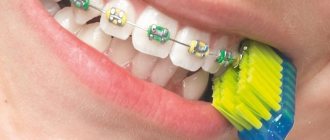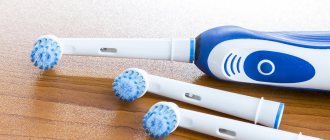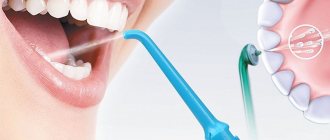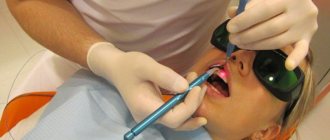From this article you will learn:
- how effective is an ultrasonic toothbrush - reviews from dentists,
- ultrasonic toothbrushes – price, rating 2022.
The article was written by a dentist with more than 19 years of experience.
An ultrasonic toothbrush is one of the options for electric toothbrushes, and it is distinguished by the presence of a generator of ultrasonic waves, which loosens and removes plaque. Ultrasonic vibrations from the generator are transmitted to the bristles of the working brush head, causing them to vibrate at a frequency of 96,000,000 vibrations per minute. A special feature is that ultrasonic vibrations can propagate from the tips of the bristles deep into the tissue (about 5 mm).
Ultrasonic vibrations help weaken the attachment of pigment and microbial plaque to tooth enamel, i.e. contribute to its loosening. In addition, the penetration of ultrasound into tissues by 5 mm (from the point of contact of the bristles with the tooth surface) should ensure therapeutic effectiveness even in the depths of periodontal pockets and interdental spaces. It sounds good – especially for patients with gum disease, but in reality everything is not so rosy.
Ultrasonic brush: photo
The first ultrasonic toothbrush appeared in 1992, and it was produced under the Ultrasonex® brand (USA). Initially, this toothbrush contained only an ultrasound generator, but a few years later the manufacturer launched an improved model on the market, which, in addition to the ultrasound generator, also had a motor that generates sound waves. And at the moment there are ultrasonic toothbrushes that can work only due to ultrasound, or due to a combination of ultrasonic and sound vibrations.
In addition, you must distinguish ultrasonic toothbrushes from sonic ones (for example, such as Philips Sonicare, Donfeel or Xiaomi Soocas). These brushes do not have an ultrasonic generator, but only a motor that generates sound vibrations of the bristles - on average, usually somewhere from 20,000 to 40,000 vibrations per minute, but some advanced models produce even 60,000 vibrations per minute. Thus, the bristles of sonic toothbrushes make significantly fewer oscillations per minute (compared to ultrasonic ones), but the amplitude of the oscillatory movements will be greater.
Important: many manufacturers deceive consumers by calling their sonic toothbrushes ultrasonic. For example, if you see a product like “Xiaomi Soocas Ultrasonic Toothbrush” in an online store, then know that it is actually a sonic brush. It should be noted that there is a huge range of sonic toothbrushes, but only a few models of ultrasonic brushes are sold in Russia. And we have listed them below –
- Megasonex m8,
- Emmi-dent 6 Professional,
- Emmi-Dent 6 Platinum.
How does an ultrasonic toothbrush work?
An ultrasonic toothbrush contains a piezoceramic plate located under the bristles of the toothbrush head. This plate emits an ultrasonic vibration wave with a frequency of 1.6–1.7 MHz. Thanks to this, the bristles on the head of the toothbrush make about 100,000,000 oscillatory movements per minute. Below you can see how the Megasonex ultrasonic toothbrush works.
Operation of the Megasonex ultrasonic brush (video 1) –
We have already said above that the piezoceramic plate generating ultrasound is located in the head of each replaceable nozzle (right at the base of the bristles). The nozzle must be changed - at least once every 3 months, even without visible wear of the bristles of the replacement nozzle. This is due to the fact that during the operation of the nozzle, the piezoceramic plate wears out, and over time, the power of the ultrasound generated by it decreases.
Differences between sonic toothbrushes –
Sonic-type brushes generate oscillatory waves not in the ultrasonic range, but in the sonic range (i.e. their frequency is much lower). Therefore, their bristles make a much smaller number of oscillatory movements - on average from 20,000 to 40,000 per minute, and some of the most advanced models up to 60,000 vibrations per minute. At the same time, we once again draw your attention to the fact that the amplitude of the oscillatory movements of the bristles of sonic brushes will be greater than that of ultrasonic brushes, and this is clearly visible when comparing the two videos.
Operation of the Xiaomi Soocas sonic brush (video 2) –
Important: the operation of a sonic toothbrush in water looks more impressive than the Megasonex ultrasonic toothbrush. The flow of liquid and microbubbles are formed more actively here, but a glass of water is just a glass of water, and not the oral cavity. The fact is that when brushing your teeth, there will never be such a volume of liquid in your mouth that the oscillating bristles can drive it so intensely through the interdental spaces. In general, this test is far from practical, but it clearly demonstrates the difference in the amplitude of vibration of the bristles of sonic and ultrasonic toothbrushes.
When considering the purchase of an ultrasonic toothbrush, remember that these devices definitely cannot be used by pregnant women, cancer patients, patients with diabetes, and patients with pacemakers.
Are there any contraindications
You should not purchase such a device if there are the following contraindications:
- Pregnancy period.
- Wearing a pacemaker.
- Oncology.
- Benign tumors in the oral cavity.
- Initial stages of caries.
- Inflammation of the gums and mucous membranes of various types.
- The thinness of natural tooth enamel.
- Availability of fillings, dentures and veneers.
Don't miss the most popular article in the section: Fashionable haircut for short hair. Photo, front and back views.
Ultrasonic toothbrush: price 2022
This section lists toothbrushes sold in Russia that use ultrasound. Brushes such as Omron, Panasonic, Philips, Donfeel, Xiaomi are not ultrasonic, but sonic brushes, and therefore read about them by clicking on the appropriate link. Below we compare several toothbrushes with each other (all prices are for 2022).
1) Ultrasonic brush Megasonex m8 –
Ultrasound frequency 1.6 MHz – 96 million vibrations per minute. However, what makes this brush different from others is that in addition to ultrasound, it simultaneously generates sound waves (like Sonicare sonic toothbrushes). It has 3 operating modes – intensive, gentle, ultrasound only. The kit contains a charger, 2 replacement tips and a travel case. Ultrasonic toothbrush Megasonex – price from 10,800 rubles.
Ultrasonic brush Megasonex –
Important features of Megasonex:
- a combination of ultrasonic and sound waves (in the “intense” mode - in addition to ultrasonic waves, you will receive 18,000 sound vibrations of the bristles per minute, in the “gentle” mode – 9,000 vibrations per minute),
- Due to the presence of sound waves, the bristles perform oscillatory movements of higher amplitude, i.e. this is an analogue of the sweeping movements of the bristles of sonic toothbrushes (such movements will allow you to sweep away dental plaque loosened by ultrasound from the surface of the teeth),
- there is an “ultrasound only” mode (without sound vibrations and vibrations) - this mode is absolutely silent, and the operation of the brush can only be understood by the green indicator light,
- ultrasound penetration depth 5 mm,
- teeth are brushed with light pressure (about 150 g) so that the bristles sweep away plaque after ultrasound has weakened its attachment to the tooth enamel,
- the brush is completely silent in the “ultrasound only” mode (there is no vibration of the handle, unlike most other brushes), but if the combined mode with sound waves is turned on, vibration will be present,
- more affordable cost of replacement nozzles (from 800 rubles for 2 pcs.),
- Additionally, you can purchase a “tongue scraper” attachment,
- 2 year warranty.
Minuses:
- no pressure sensor,
- The charge indication works “so-so”, so if you feel that the power has decreased, you need to immediately charge the brush,
- The manufacturer does not indicate the power of the ultrasonic generator.
Equipment Megasonex m8 (video) –
2) Ultrasonic brush “Emmi-dent 6 Professional” –
Ultrasound frequency 1.6 MHz (96 million vibrations per minute), 1 standard operating mode. The kit includes 2 attachments, 1 tube of Emmi-dent Fresh toothpaste, a case and a charger. Emmi-dent 6 Professional toothbrush – price from RUB 13,000. It should be noted that there is also an older model - “Emmi-Dent 6 Platinum” for 18,000 rubles, which in terms of functionality is practically no different from the younger model, except for an improved charger.
“Emmi-Dent” brushes (Professional/Platinum) –
While analyzing the Emmi-Dent website, unfortunately, I came across aggressive marketing and false statements. For example, they say that only their brushes have an ultrasonic generator (piezoceramic plate) located directly in the head of the toothbrush, i.e. right under the bristles of the replacement heads. But in fact, Megasonex m8 has exactly the same design. In addition, the Emmi-Dent website contains inaccurate information that when brushing your teeth with an ultrasonic toothbrush, you should only use toothpaste with zero abrasiveness (by luck - their own production). But now about the important thing.
Important features of Emmi-dent brushes:
- generate only ultrasound, i.e. there is no combination with sound waves,
- high power ultrasonic generator – 0.2 W,
- the manufacturer does not say to what depth ultrasound penetrates, but claims that the antibacterial effect of air bubbles formed in the liquid when ultrasound passes through it extends deep into the gums up to 12 mm (it’s difficult to comment on this :)),
- Previously, the manufacturer of Emmi-dent brushes said that you don’t even have to touch your teeth with their brush, but now they have changed the strategy and say that it is necessary to touch the teeth with the bristles, but without pressure (and this makes sense, since air represents acts as a barrier to ultrasonic waves),
- During operation, Emmi-dent creates a forced vibration of the brush handle so that the user understands that the brush is working (normally, the operation of the ultrasonic generator should be absolutely silent).
Minuses:
- generates only ultrasound (no combination with sound waves),
- the handle of the Emmi-dent 6 Professional and Emmi-Dent 6 Platinum ultrasonic toothbrushes is not very comfortable (especially when compared with Megasonex, which is comfortable and pleasant to hold in your hand).
- design - so-so
- higher cost of replacement nozzles (from 1200 rubles for 2 pieces),
- The bristles of the Emmi-dent attachments are quite coarse,
- they write that the product was made in Germany, but in fact in China,
- they write that you can only use their “Emmi-dent” toothpaste with an RDA of zero (i.e. zero abrasiveness, which is certainly nonsense, since modern abrasives in toothpastes are spherical cut and do not scratch tooth enamel,
- Well, the most important disadvantage is below.
Important: in fact, the Emmi-dent brush removes pigmented and microbial plaque rather mediocrely (especially if you use their non-abrasive toothpastes). And the reason for this is very simple. The fact is that ultrasound only loosens plaque well, and does not remove it from the surface of the teeth or from the interdental spaces. The manufacturer, trying to give its product unique properties, says that you do not need to touch your teeth with bristles and make traditional sweeping movements.
Therefore, the plaque actually loosens, but remains on the teeth, because Unlike the Megasonex brush, the Emmi-dent bristles do not have a large amplitude of oscillatory movements that would be capable of sweeping away plaque. And just rinsing your mouth after brushing to remove loose plaque will not be enough. Therefore, some of the attached plaque will definitely remain. And the same thing is true with dental deposits in periodontal pockets or interdental spaces.
The brush manufacturer Megasonex is more truthful in its promises, and honestly says that a little pressure when brushing your teeth is still necessary. But the fact is that Megasonex brushes, in addition to ultrasonic vibrations, have bristles that vibrate in the audio range (i.e. with a much larger amplitude), making small sweeping movements similar to those of sonic toothbrushes. Those. in this case, we are ready to talk about the advantage of those ultrasonic toothbrushes in which ultrasonic vibrations are combined with sonic ones.
Comparison of the power of the ultrasonic generator for Megasonex and Emmi-dent toothbrushes –
does not disclose the power of the ultrasonic generator in its device, saying only that ultrasound penetrates to a depth of 5 mm. But independent measurements show that Megasonex actually has less power than, for example, Emmi-dent toothbrushes. The latter have a declared generator power of 0.2 W, but they do not write to what depth the ultrasound propagates (they only write about the “depth of the antibacterial effect of the formed air bubbles” - equal to 12 mm).
At first glance, the lower power of the ultrasound generator may seem like a disadvantage of Megasonex ultrasonic brushes. On the one hand, this is true, but Megasonex works not only using ultrasound, but it also has modes in which ultrasonic waves are combined with sound waves. And we can safely say that this combination cleans teeth much better than high-power ultrasound alone. The fact is that when working only in the ultrasonic range, the bristles of the nozzle have very small vibrations and do not perform sweeping movements, removing loosened plaque from the surface of the teeth. Ultrasound only loosens plaque. The sonic vibrations of the bristles have a much larger amplitude, simulating the sweeping movements of a manual brush and fully sonic toothbrushes.
Important: in addition, below in the article we will also tell you about the disadvantages of powerful ultrasound. The negative effects of the passage of ultrasonic waves develop primarily at the interface of media, for example, filling/tooth or artificial crown/cement/tooth, etc. And this leads to a gradual weakening of the fixation of composite filling materials, gradual destruction of cement under artificial crowns, etc.
Technique
Implant dentures must be treated in the same way as regular teeth. The protruding parts of the implants and their lower areas touching the gums must be thoroughly cleaned. Cleaning is performed at least twice a day (in the morning and evening) using one of two techniques .
Regular
- Move the brush from top to bottom along the outside of the implants.
- Using sweeping movements from bottom to top, plaque is removed from the posterior (lingual) wall of the dentures.
- Clean the upper part of the implant in a circular motion, simultaneously massaging the gums.
Bass method - a special cleaning technique
- Tilt the toothbrush at an angle of 45 degrees to the denture so that the bristles barely penetrate the gingival sulcus.
- Perform light back-and-forth movements.
- Additionally, create a slight vibration effect so that the tips of the bristles do not leave the gingival sulcus.
- Each movement should have a short amplitude.
- It is necessary to allocate 4 - 5 minutes to treat the entire dentition.
It is most convenient to use the Bass method in the morning; with its help, plaque is effectively removed above and below the gum.
How to brush your teeth with an ultrasonic brush –
Wet the bristles of your toothbrush head and apply a strip of toothpaste to it. You can use the most ordinary toothpaste, and under no circumstances listen to recommendations that you can only use their toothpaste with zero abrasiveness. The only thing you should not use is whitening toothpastes (as they tend to be more abrasive than RDA 100).
Next, you should spread the toothpaste over the inner and outer surfaces of your teeth. Place the head of the brush with bristles against the surface of your teeth. You can start with the upper row of teeth on the outside, then move inside, and then move to the lower row of teeth from the inside and outside. You should simply press the bristles of the brush head against your teeth without making any movements with the handle of the toothbrush. The coverage of the brush head is 2 teeth; rest the brush against your teeth, wait 5 seconds - then move the brush to the next section of the dentition.
After finishing cleaning, you should, without turning off the brush, rinse the bristles under running cool tap water and then turn it off. Charge your ultrasonic brush from time to time (especially if you notice a decrease in the sonic vibration power of the bristles). You should not allow the brush to completely lose its charge, because... this will reduce the battery life. Change the replacement brush as soon as you notice that the bristles are no longer completely straight, and at least once every 3 months. On the Megasonex m8 brush, the nozzle can be changed in a clever way (there is a special lever) - the video below shows how this is done.
Nuances of choice
- Thorough cleaning of the tooth surface is possible with a sufficient length of the working part - 2-2.5 cm. This size is designed to capture several teeth at the same time.
- The head of the brush should be rounded so as not to injure the mucous membrane. The unevenness of the outer part provides additional hygiene.
- The movable junction between the head and the handle puts moderate pressure on the crowns and gums.
- The handle with rubber inserts makes the brush more comfortable to use and prevents it from slipping in your hands.
Need to consider:
- Ultrasonic and ionic models greatly facilitate care, but are less accessible due to their high cost.
- Electric ones effectively cope with the function of cleaning teeth. Do not use for gum diseases or unhealed sutures.
- Manual ones are cheaper than others, but are effective only if the correct movements are performed.
Ultrasonic toothbrushes: reviews, disadvantages
It is better to read reviews of an ultrasonic toothbrush on Amazon (with a browser translator), or on Yandex Market or Ozone. The last two sites also have truthful reviews, but most of the positive comments have nothing to do with reality. The most important thing is that ultrasonic toothbrushes actually do not clean your teeth as well when you compare them to Oral-B brushes, as well as sonic toothbrushes.
I understand that as a dentist, it is much easier for me to distinguish truthful reviews from commercial ones. And I will give you the following example. One of the buyers in the review noted that the quality of oral hygiene after purchasing an ultrasonic toothbrush worsened, and within a couple of weeks small dental deposits became noticeable on the teeth, i.e. tartar. To which commentators (who had previously written positive reviews themselves) began to accuse him of deception, arguing that nothing like that could happen, because The process of tartar formation itself is too slow and occurs in at least six months.
So, in order to evaluate the professionalism of such commentators (I think related to the promotion of ultrasonic brushes on the Internet), it is worth noting that the formation of tartar can occur in just 1 week. Tartar is formed from soft microbial plaque - through its gradual mineralization by calcium salts contained in saliva. The rate of mineralization is different for all people, but if you haven’t brushed your teeth well and there is soft microbial plaque left somewhere on the surface of the enamel, its partial mineralization occurs on average in just 12-16 hours.
Partially mineralized plaque is not as hard as tartar, but it is already firmly attached to the tooth enamel and cannot be completely removed with a regular toothbrush. In addition, it makes the enamel rough, which promotes the rapid deposition of new portions of soft plaque (and their subsequent mineralization). Thus, if you change your brush and it doesn’t clean your teeth well, you can notice the appearance of tartar in 1 week, 2 weeks, or 1 month. Differences in timing will depend on how poorly the brush copes with microbial plaque, and exactly how much microbial plaque remains on your teeth.
Important: many patients ask about the possibility of removing tartar with an ultrasonic toothbrush, probably thinking that this could be an alternative to ultrasonic teeth cleaning at the dentist. Unfortunately, this cannot be an alternative, and an ultrasonic brush will not be able to rid you of existing hard plaque. Of course, some fragments of dental plaque may “break off” from the tooth enamel, but the surface of the enamel will still remain rough, which will lead to the rapid adhesion of new portions of plaque to the rough surface. But all this, unfortunately, is not all the disadvantages of ultrasonic toothbrushes.
Dentists' recommendations
Purchasing a toothbrush with an ultrasonic effect is a serious step towards a healthy smile. To make it as safe as possible, you need to follow some recommendations from dentists.
These are the following expert advice:
- mandatory examination by a dentist before purchasing a device;
- inadmissibility of using attachments with hard bristles to preserve the integrity of the enamel;
- mandatory supervision of children while brushing their teeth with such a device;
- analysis of the features of different models and thoughtful selection of your own copy.
Other disadvantages of ultrasonic toothbrushes –
In order to appreciate some of the disadvantages, you don’t need to be a dentist, but you just need to know a little physics. In this case, we are especially interested in the peculiarities of the passage of ultrasound through solid media (after all, ultrasound penetrates deep into tissues by 4-5 mm), and we usually have fillings, veneers and crowns on our teeth. And there's something interesting here.
1) Reduced service life of fillings, veneers, crowns –
Ultrasound is an oscillatory wave of very high frequency, which from the tips of the bristles of a toothbrush can spread 4-5 mm deep. Thus, ultrasound passing through any hard tissue (teeth, fillings, crowns, gums) creates vibrations in them, i.e. microvibrations. If we are talking about completely healthy teeth, then passing ultrasound through them does not create any problems.
But in heterogeneous solid media/materials (for example, a tooth with a filling or a crown), ultrasonic vibrations propagate differently. This is due to the fact that different materials have different wave resistance indicators, which depends on their structure, structure, and physical properties of the material. You can familiarize yourself with this from a physics course (see the laws of propagation of ultrasound in inhomogeneous solid media).
Features of the effect of ultrasound on fillings - however, a completely different situation arises in teeth that have fillings, crowns, veneers, inlays, and metal pins installed in the root canals (24stoma.ru). In terms of their physical properties, filling materials differ from tooth tissue. And therefore, when an ultrasonic vibrational wave passes through, the filling will experience vibrations (vibration) different from the vibration of the preserved tooth tissue, i.e. The filling and tooth tissue will vibrate differently. And this is where the most interesting thing happens...
The fact is that the discrepancy between microvibrations causes their conflict, which occurs at the boundary of solid media (such as the boundaries of filling/tooth, crown/tooth, metal pin/tooth). This conflict leads to the destruction of the bonding component between these solid media. For example, between a composite light-polymer filling and the tooth tissues there is always a layer of adhesive (bond), and between the veneer, crown and tooth tissues there is a cement that binds them. So, the gradual destruction of the adhesive at the filling/tooth interface gradually leads to a deterioration in the fixation of the filling to the tooth tissue over time.
And the same applies to veneers, inlays, artificial crowns, and the process of destruction will not be sudden, but gradual. As a dentist, I worked for a very long time, including in periodontal care. Here it must be said that any doctor who removes dental plaque from patients with ultrasonic scalers has to periodically deal with the loss of fillings (which, by the way, fall out quite well even without ultrasound). The first to fall out, of course, are poorly placed fillings with weak attachment of the filling to the tooth tissue. Those. Of course, ultrasonic vibrations will to some extent affect the durability of fillings and the fixation of veneers and crowns.
Is it then necessary to remove dental plaque with ultrasound at all: and you, of course, may have a reasonable question - is it then even worth removing dental plaque at the dentist using ultrasound? The fact is that usually dental plaque is removed by the dentist no more than once a year - such frequency will not cause significant harm to the fillings, unlike, for example, the constant daily use of ultrasound twice a day at home. Therefore, you should not be afraid of ultrasonic teeth cleaning at the dentist, because... such cleaning has many more advantages, preventing the development of caries, as well as gum inflammation.
2) Destruction of demineralized areas of enamel –
Some people have whitish chalky spots on the surface of the enamel (Fig. 7-8). These spots are areas of low enamel mineralization, i.e. In these areas, the tooth enamel contains too little calcium. By the way, such lesions are nothing more than the initial stage of caries, which is called caries in the white spot stage. The enamel in such areas has a matte tint, it lacks shine, and at the same time it is very fragile and porous (that is, it could easily be scraped off with a sharp instrument).
Inexperienced dentists often have situations when, when removing dental plaque from a patient with ultrasound, they touch the ultrasonic scaler attachment to such areas of fragile demineralized enamel, which leads to its destruction (formation of a defect). So, daily use of ultrasound to clean teeth can cause gradual destruction of demineralized areas of enamel, which will lead to the need for tooth filling. But, if the teeth are well mineralized, then the use of ultrasound will be safe.
3) Use for gum inflammation (gingivitis, periodontitis) –
The use of ultrasonic toothbrushes in the acute period of gum inflammation, i.e. when there is pain, suppuration, swelling, edema or bleeding - it is strictly contraindicated. This is due to the fact that the use of ultrasound in the acute period only leads to worsening inflammation (spread of infection). This banal truth is written in any physical therapy manual. But as for chronic forms of gingivitis and periodontitis, I would like to insert a few comments.
Acute and chronic forms of gingivitis –
The cause of the development of gingivitis is insufficient oral hygiene - due to which soft microbial plaque accumulates on the teeth, which causes inflammation of the gums. Patients with gingivitis - before starting to use an ultrasonic toothbrush, you must first undergo a course of professional oral hygiene from a dentist, including a 10-day course of drug therapy (including antiseptic rinses and anti-inflammatory gel applications). This course will be effective only after removing dental plaque. And then you can safely start using an ultrasonic toothbrush.
Periodontitis differs from gingivitis in that with this form of inflammation of the gums, the destruction of the dentogingival attachment itself occurs, which is expressed in the appearance of so-called “periodontal pockets” between the surface of the roots of the teeth and the gums (Fig. 16). Subgingival dental deposits are located in such pockets, i.e. subgingival tartar, consisting of a large number of pathogenic bacteria and mineral salts.
Periodontitis, periodontal pockets –
It is strictly forbidden to use an ultrasonic toothbrush if you have subgingival dental plaque. The fact is that ultrasound destroys the cell walls of pathogenic bacteria, leading to the release of a large number of toxins and inflammatory mediators into the lumen of periodontal pockets. And this will certainly lead to an increase in gum inflammation, including accelerated destruction of the periodontal attachment and bone tissue around the tooth. Therefore, I would categorically not use an ultrasonic brush until subgingival dental plaque is completely removed (and even after that).
Bone tissue in the area of periodontal pockets is not simply destroyed - it is replaced by soft inflammatory granulation tissue. By the way, these granulations (together with subgingival dental deposits) are removed during flap operations, which are the main method of treating periodontitis. Granulation tissue contains a large number of osteoclasts - cells that actively resorb bone tissue. Under the influence of ultrasound, the activity of osteoclasts in granulation tissue increases, which automatically leads to an increase in the rate of destruction of bone tissue, and the appearance of tooth mobility over time.
Therefore, all the assurances that ultrasonic toothbrushes are very useful for periodontal diseases are very, very, very far from the truth. And it would be more useful for you to use not an ultrasonic, but a sonic toothbrush in combination with an oral irrigator.
Principle of operation
Cleaning teeth with an ultrasonic brush is carried out by a motor located inside the handle, which triggers a piezoceramic plate that produces oscillatory waves.
Under the influence of ultrasound, the villi begin to move, eliminating bacterial plaque and food particles.
Need to know! During the cleaning process with an ultrasonic type device, the oral tissues are slightly heated.
Thanks to this, the active components of the toothpaste penetrate deep and have a positive effect on the condition of the teeth.
Conclusions -
As a dentist, I would not recommend using ultrasonic toothbrushes to my patients. And even if the choice of the Megasonex m8 toothbrush seems preferable to me (in comparison with the Emmi-Dent brushes), then I think that both of these brushes are absolutely not up to the quality of teeth cleaning - modern sonic brushes, and especially before Oral-B electric brushes. The latter are, in fact, a dentist’s instrument in miniature. Read more about them in the article linked below.
→ Electric toothbrushes
What paste is recommended to use?
Some manufacturers produce special toothpastes with a gentle abrasive system.
It is these pastes that are recommended to be used in conjunction with an electric ultrasonic device.
Note! You can also use regular pastes that do not contain fine particles for daily oral care.
Experts advise purchasing toothpastes labeled “For electric toothbrushes” , having first studied the composition of the cleaning product.
It is desirable that the paste contains phosphorus and calcium, which help strengthen and whiten tooth enamel.
The future belongs to atomic toothbrushes
You probably already understood from the title that it was written with irony. In the modern world, unfortunately, everything is tied to money and trade. We can already predict that in the very next few years there will appear “atomic toothbrushes”, “magnetic resonance toothbrushes”, as well as other products with artificially developed demand, the purpose of which is only one thing - to make money by introducing the next useless “new product” to the market "
The fact is that the toothbrush market has one feature characteristic of mass-market products - toothbrushes are a product with a short life cycle (a marketing term). That is why manufacturers of such goods constantly release new products to the market, so that the buyer makes a choice in favor of their new product, because a new product is always easier to sell - even at a higher price than its competitors. Therefore, I consider ultrasonic toothbrushes a completely dead product with artificially developed demand. We hope that our article on the topic: Ultrasonic toothbrush reviews was useful to you!
Sources:
1. Dental education of the author of the article, 2. Based on personal experience in the use of electricity. toothbrushes, 3. National Library of Medicine (USA), 4. American Academy of Periodontology (USA), 5. https://megasonex.com/, 6. https://www.realself.com/.
Are they suitable for children?
Ultrasonic toothbrush models are ideal for children .
You should know! With their help, the baby will be able to thoroughly clean the teeth and perform a light massage of the gums, which is necessary to increase the stability of periodontal tissues and stimulate metabolic processes.
Children can start using the device as early as five years of age under adult supervision.
All models of toothbrushes intended for children are designed taking into account the development of children's teeth. Therefore, children should not use adult hygiene devices.

